Signs of Gallbladder Disease
The most common form of gallbladder disease is gallstones and affects more than 20 million Americans annually. Gallstones are generally a symptomatic. They may be discovered during a surgical procedure for an unrelated condition or during autopsy. The primary clinical sign is an inflamed gallbladder, called cholecystitis. While less common, patients with severe cases may develop gallstone pancreatitis, gallbladder perforation, or other gallbladder diseases.
What is the Gallbladder and What does it do?
The gallbladder is a small sac-like storage compartment for bile, which is made in the liver. Bile is released from the gallbladder into the small intestines via a duct referred to as the cystic duct. The entire process is meant to break down foods (namely fatty foods). Besides the bile, pancreatic enzymes help digest food. The disease process of an inflamed gallbladder most commonly involves the impaction of gallstones in the bladder neck, Hartmann's pouch, or the cystic duct. Gallstones are not the cause of an inflamed gallbladder. Pressure on the gallbladder increases due to the backup of bile from the liver, the organ becomes enlarged, the walls thicken, the blood supply decreases, and pus may form. Cholecystitis can be either acute or chronic, with repeated bouts of acute inflammation potentially leading to chronic cholecystitis.
The gallbladder can become infected by various bacteria and can get so damaged as to lead to gangrene or sepsis, a systemic bacterial blood infection. Cholecystitis can lead to gallstone pancreatitis if stones dislodge and block the sphincter of Oddi, which is the muscle that controls the opening and closing of the pancreatic duct. Acute pancreatitis is when the pancreatic enzymes build up in the pancreas because they can’t get to the intestines.
Risk Factors
• Genetic and environmental factors
• Female gender
• Previous pregnancies
• Family history of gallstone
• High dietary intake of fats and carbohydrates which increases Cholesterol secretion into the bile that becomes oversaturated.
• Sedentary lifestyle,
• Type 2 diabetes mellitus
• Dyslipidemia (increased triglycerides and low HDL).
• Coronary artery disease
• Lactose intolerance
Signs and Symptoms
Gallstones are generally asymptomatic. Symptoms include:
• Mild nausea
•Vomiting
• Abdominal discomfort
• Biliary colic-sharp upper abdominal or right-sided pain under the ribcage. The pain may shoot towards the back or right shoulder
• Jaundice.
• Poor appetite
• Diarrhea
• Dark urine
• Light colored stools or change in bowel habits
Cholecystitis presents similarly to the above but the obstruction of the gallbladder (cystic) duct is persistent and fever is common.
A patient with cholecystitis also may exhibit Murphy's sign
(discomfort so severe that the patient stops breathing during someone pushes a hand in the abdomen over the gallbladder) or jaundice.
Jaundice, a yellow discoloration of the skin and the sclera of the eyes, occurs when the common bile duct is blocked from a stone. Bile is made of bilirubin and when it builds up, it must be broken down and released into the blood stream, creating a yellow color in the skin and eyes. Other nonspecific symptoms are:
• Indigestion
• Intolerance to fatty or fried foods
• Belching
• Flatulence
Treatment of Gallbladder Diseases
The treatment of choice for symptomatic cholelithiasis currently is laparoscopic cholecystectomy. Nonoperative therapy, which includes dissolution of gallstones using oral bile acids and shock wave lithotripsy, may be other options. Oral bile acids are most effective for small gallstones (0.5–1 cm) and may take up to 24 months to clear the stones. Ursodiol is the most commonly used oral bile acids. Nutrition and lifestyle changes may be beneficial for the prevention and treatment of cholelithiasis. Weight loss that is gradual may help prevent gallstone formation. Dietary factors that may help prevent gallstone formation include the intake of polyunsaturated fat, monounsaturated fat, fiber, and caffeine. Fish oil and moderate alcohol consumption have been shown to lower triglycerides, lessen bile cholesterol saturation, and increase HDL.
Foods to Avoid with Gallbladder Issues
Avoid the following foods for a healthy gallbladder diet:
•Trans-fat
• Processed foods
• Vegetable or peanut oil
• Refined white foods (breads, pastas, etc.)
• Foods high in fat
• Alcohol
• Tobacco





